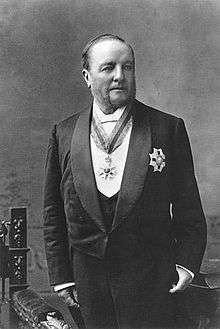Frederick McCoy
| Sir Frederick McCoy KCMG FRS | |
|---|---|
 | |
| Born |
1817 Dublin |
| Died |
16 May 1899 Melbourne |
| Occupation | Professor of Natural Sciences at the University of Melbourne |
| Awards |
Murchison Medal (1979) Clarke Medal (1881) |
Sir Frederick McCoy KCMG FRS (1817 – 16 May 1899), was an Irish palaeontologist, zoologist, and museum administrator, active in Australia. He is noted for founding the Botanic Garden of the University of Melbourne in 1856.[1]
Early life
McCoy was the son of Simon McCoy and was born in Dublin; some sources have his year of birth as 1823, but 1817 is the most likely. He was educated in that city and at Cambridge for the medical profession.
Palaeontology career
McCoy's interests, however, became early centred in natural history, and especially in geology, and at the age of eighteen he published a Catalogue of Organic Remains compiled from specimens exhibited in the Rotunda at Dublin (1841). He assisted Sir RJ Griffith by studying the fossils of the carboniferous and silurian rocks of Ireland, and they prepared a joint in 1844 appeared A Synopsis of the Character of Carboniferous Limestone Fossils of Ireland (1844) and Synopsis of the Silurian Fossils of Ireland (1846).
In 1846 Sedgwick secured his services, and for at least four years he devoted himself to the determination and arrangement of the fossils in the Woodwardian Museum at Cambridge. Sedgwick wrote of him as "an excellent naturalist, an incomparable and most philosophical palaeontologist, and one of the steadiest and quickest workmen that ever undertook the arrangement of a museum" (Life and Letters of Sedgwick, ii. 194). Together they prepared the important and now classic work entitled A Synopsis of the Classification of the British Palaeozoic Rocks, with a Systematic Description of the British Palaeozoic Fossils in the Geological Museum of the University of Cambridge (1855). Meanwhile, McCoy in 1850 had been appointed professor of geology in Queen's College, Belfast.
Career in Australia
In 1854, McCoy accepted the newly founded professorship of natural science in the University of Melbourne. There he lectured for upwards of thirty years. When McCoy began his work at the university there were few students, and for many years he took classes in chemistry, mineralogy, botany, zoology, comparative anatomy, geology and palaeontology. In endeavouring to cover so much ground it was impossible for him to keep his reading up to date in all these sciences, and he remained most distinguished as a palaeontologist. He established the National Museum of Natural History and Geology in Melbourne, of which he was director; and becoming associated with the Geological Survey of Victoria as palaeontologist, he issued a series of decades entitled Prodromus of the Palaeontology of Victoria. He also issued the Prodromus of the Zoology of Victoria. He was president of the Royal Society of Victoria in 1864 and vice president in 1861 and 1870.
Frederick McCoy is the taxon author of three species of Australian venomous snakes,[3] including Oxyuranus microlepidotus, commonly known as the inland taipan or fierce snake, which is considered to be the world's most venomous snake.[4]
Late life
McCoy contributed many papers to local societies, and continued his active scientific work for fifty-eight years – his last contribution, "Note on a new Australian Pterygotus," was printed in the Geological Magazine for May 1899. He was awarded the Murchison Medal of the Geological Society of London in 1879, was elected F.R.S. in 1880, and was one of the first to receive the Hon. D.Sc. from the University of Cambridge.[5] In 1886, he was made CMG, and in 1891 KCMG. He died in Melbourne on 16 May 1899.[6]
A species of Australian lizard, Anepischetosia maccoyi, is named in his honor.[7]
References
- ↑ Botanist, Museums Victoria, retrieved 30 November 2016
- ↑ "Wanted: Dead or Alive". Museum Victoria. Retrieved 25 November 2014.
- ↑ The Reptile Database. www.reptile-database.org.
- ↑ Ernst, C.H., and G.R. Zug. 1996. Snakes in Question: The Smithsonian Answer Book. Washington, District of Columbia: Smithsonian Institution Press.
- ↑ "McCoy, Frederick (MY887F)". A Cambridge Alumni Database. University of Cambridge.
- ↑ Obituary (with bibliography) in Geol. Mag. 1899, p. 283.
- ↑ Beolens B, Watkins M, Grayson M. 2011. The Eponym Dictionary of Reptiles. Baltimore: Johns Hopkins University Press. xiii + 296 pp. ISBN 978-1-4214-0135-5. ("McCoy, F.", p. 172).
- ↑ IPNI. McCoy.
Sources
 Bonney, Thomas George (1901). "McCoy, Frederick". In Sidney Lee. Dictionary of National Biography, 1901 supplement. London: Smith, Elder & Co.
Bonney, Thomas George (1901). "McCoy, Frederick". In Sidney Lee. Dictionary of National Biography, 1901 supplement. London: Smith, Elder & Co.  This article incorporates text from a publication now in the public domain: Chisholm, Hugh, ed. (1911). "McCoy, Sir Frederick". Encyclopædia Britannica. 17 (11th ed.). Cambridge University Press. p. 206.
This article incorporates text from a publication now in the public domain: Chisholm, Hugh, ed. (1911). "McCoy, Sir Frederick". Encyclopædia Britannica. 17 (11th ed.). Cambridge University Press. p. 206.- Serle, Percival (1949). "McCoy, Frederick". Dictionary of Australian Biography. Sydney: Angus and Robertson.
- G. C. Fendley, 'McCoy, Sir Frederick (1817 - 1899)', Australian Dictionary of Biography, Volume 5, MUP, 1974, pp 134–136.
External links
- Caught and Coloured: Zoological Illustrations of Colonial Victoria, Museum Victoria, Melbourne Australia
- Sir Frederick McCoy (1817/23-1899) Gravesite at Brighton General Cemetery (Vic)
| Awards | ||
|---|---|---|
| Preceded by Thomas Huxley |
Clarke Medal 1881 |
Succeeded by James Dwight Dana |